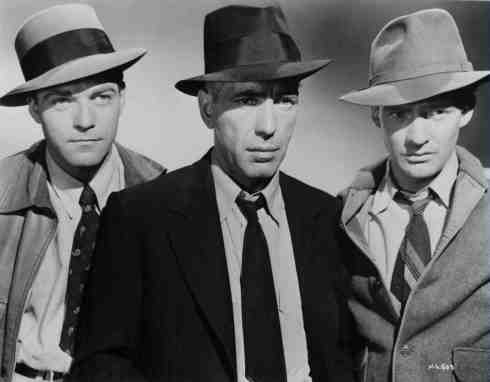 Lead character Mad Dog Earle is a cold-blooded killer at the beginning of High Sierra (1941). But by the end he’s helped heal a disabled young woman and fallen hard for a cocktail dancer named Marie (Ida Lupino), in a rare noir western that would be the breakthrough film cementing Humphrey Bogart’s A-List Star status. Unlike Private Investigator Sam Spade, the main character in the Maltese Falcon, also made in 1941 and starring Bogart, Roy Earle is a hardened criminal. The character is the literal half-way point for Bogie’s evolution from B-movie gangster tough guy to screen preeminence as ultra-cool, bowtie and tuxedo wearing Rick Blaine in Casablanca (1942).
Lead character Mad Dog Earle is a cold-blooded killer at the beginning of High Sierra (1941). But by the end he’s helped heal a disabled young woman and fallen hard for a cocktail dancer named Marie (Ida Lupino), in a rare noir western that would be the breakthrough film cementing Humphrey Bogart’s A-List Star status. Unlike Private Investigator Sam Spade, the main character in the Maltese Falcon, also made in 1941 and starring Bogart, Roy Earle is a hardened criminal. The character is the literal half-way point for Bogie’s evolution from B-movie gangster tough guy to screen preeminence as ultra-cool, bowtie and tuxedo wearing Rick Blaine in Casablanca (1942).

Bogart’s breakthrough-role involves the wide-ranging emotional landscape Bogart would dominate in from the early-40’s into the early-to-mid fifties. But in 1941, he was breaking into the mainstream as a tough guy with a heart. Bogart’s characters would still be tough and more than able to defend themselves, simultaneously someone you wouldn’t want to mess with while every woman in the world secretly wanted to be in love with – they would mellow over time like fine aged whiskey.

High Sierra is known for being the movie where Bogart showed true range. He let’s himself fall in love with Marie – yet remains wildly unstable. And while the film may seem dated to some, unlike Falcon and Casablanca which seem to retain their style and freshness timelessly – High Sierra is well worth-watching to see the genesis of the Bogart character coming into it’s own. Mad Dog has a vulnerability that is meant to be ironic and against-type, and it’s exactly the role Bogart needs to test the romantic waters for Casablanca.

Bogart was not at all sure audiences would buy him as a romantic lead in 1942. It was the experience of shooting High Sierra that gave him the initial confidence to take the Casablanca role. And while Sam Spade was toying with Brigette O’Shaunessy (Mary Astor), through most of Maltese Falcon, Rick is truly smitten with Ilsa (Ingrid Bergman) in Casablanca. The vulnerability Bogart is able to show and still remain manly and tough in Casablanca began in High Sierra. I won’t spoil the ending, but just watch for the moment when Bogart’s Roy Earle decides maybe love is worth sacrificing for, if not the greater good.

Bogart with his trademark Mad Dog Earle haircut yukking it up with his High Sierra director, Raoul Walsh.











